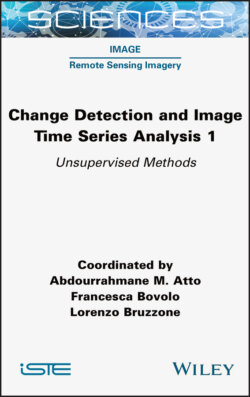Читать книгу Change Detection and Image Time-Series Analysis 1 - Группа авторов - Страница 16
1.2.3. Spectral–spatial unsupervised CD techniques
ОглавлениеDespite the success of aforementioned CD methods, especially the CVA-based methods, they mainly focus on the spectral changes in each individual pixel or a local neighborhood (Bovolo 2009; Bovolo et al. 2012; Liu et al. 2015). The geometrical characteristics of change targets are not fully modeled and preserved. This may increase the ambiguity due to abnormal spectral variations in isolated pixels and errors (e.g. co-registration errors), leading to the presence of omission and commission errors, especially when dealing with VHR images. In this case, traditional pixel-based CD methods may lose their effectiveness since they were developed under the assumption that pixels are spatially independent. However, for multispectral images in complex urban scenarios, challenging issues may arise due to the limited spectral representation; thus, the same class of objects may have different spectra, or different objects may have the same or very similar spectra. This may significantly increase the detection difficulty, especially when considering the multiclass CD task.
To address the above problems in pixel-based CD (PBCD) techniques, spectral–spatial joint analysis and object-based CD (OBCD) methods are mainstream techniques proposed in the literature. For the former, morphological filters (i.e. self-dual reconstruction filters and alternating sequential filters) were combined with CVA for binary CD in VHR images (Mura et al. 2008). However, a sliding window (i.e. structuring element (SE)) for filtering should be fixed at a given level; thus, it is not robust for multilevel implementation. Morphological attribute profiles (APs) were applied to extract structure-related geometrical features within the scene from each date of panchromatic images (Falco et al. 2013). It includes a multilevel extraction of connected regions in the scene at different scales. Building change information based on the difference in the multitemporal morphological building index (MBI) at the feature and decision level was considered for detecting building changes in VHR images (Huang et al. 2014). A spectral–spatial band expansion approach was developed to enhance the change representation in multispectral images with limited bands, where additional bands were generated from both spectral and spatial viewpoints (Liu et al. 2019b).
For OBCD methods, four main categories exist: image-object, class-object, multitemporal-object and hybrid CD (Chen et al. 2012; Hussain et al. 2013). An object-based CD approach was designed in (Liu and Du 2010), which analyzes different spectral and texture features extracted during the segmentation process from two independent time images. A superpixel segmentation was applied to stacked bitemporal images, and several derived features were used to describe changes in the difference image according to the supervised classification (Wu et al. 2012). An objected-based method was designed to create objects in each single-time image according to segmentation and then generated different representative features (Wang et al. 2018). A weighted Dempster–Shafer theory (wDST) fusion OBCD method was proposed by combining multiple PBCD results, which can automatically calculate and assign a certainty weight for each object of the PBCD result while considering the stability of an object (Han et al. 2020). However, the selection of the optimal segmentation scale is still an open issue and was mainly implemented based on the empirical analysis in OBCD methods (Kaszta et al. 2016). Moreover, most of the above existing work focused on solving a binary CD problem, and very few were designed for dealing with the more challenging unsupervised multiclass CD case (Liu et al. 2019b).
Accordingly, the following problems should be further analyzed: (1) how spatial neighboring pixels have an impact on unsupervised change representation and detection; (2) how to effectively model structural and geometric information of change targets to enhance change representation; (3) how to integrate multiscale and multidimensional change descriptions to increase change separability; (4) how to adaptively find a suitable segmentation scale in the unsupervised OBCD approach. In this chapter, we investigate these issues and develop new spectral–spatial CD approaches in multitemporal multispectral images.
